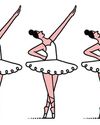
Chop down a poplar tree. Other kinds of wood could work, too, but poplar is an especially soft one, and your task is to trim it into thin planes. These you'll need to coat in a barrier of plaster and animal gluenaked wood is highly absorbent, and you can't have it drinking down everything you put on it. Wait until the barrier has dried. Sand. Repeat until you have a perfectly smooth surface.
Sketch your preferred silhouettes with a stick of charcoal, slather the negative space in a gluey reddish mixture, cover that in translucent gold leaf (glueless, the metal has a queasy green tinge), and burnish that with a wolf's tooth. Now, and only now, you may pick up your brush.
The Met's new show about what happens next, "Siena: The Rise of Painting, 1300-1350," makes clear how astonishing it is that paint, of all things, became the center of Western art. Gold was prettier. Wood was tougher. Textile and ivory, both well represented here, travelled from city to city more freely. Nobody ever looked at an egg yolk, the signature ingredient in tempera, and thought "sublime," let alone "enduring," but here we are, seven centuries later. There may never be another big American exhibition about this freakish little era, when artists figured out how to make colorful ooze do their bidding.
This story is from the {{IssueName}} edition of {{MagazineName}}.
Start your 7-day Magzter GOLD free trial to access thousands of curated premium stories, and 9,000+ magazines and newspapers.
Already a subscriber ? Sign In
This story is from the {{IssueName}} edition of {{MagazineName}}.
Start your 7-day Magzter GOLD free trial to access thousands of curated premium stories, and 9,000+ magazines and newspapers.
Already a subscriber? Sign In

THE FRENZY Joyce Carol Oates
Early afternoon, driving south on the Garden State Parkway with the girl beside him.

UPDATED KENNEDY CENTER 2025 SCHEDULE
April 1—A. R. Gurney’s “Love Letters,” with Lauren Boebert and Kid Rock

YOU MAD, BRO?
Young men have gone MAGA. Can the left win them back?

ONWARD AND UPWARD WITH THE ARTS BETTING ON THE FUTURE
Lucy Dacus after boygenius.

STEAL, ADAPT, BORROW
Jonathan Anderson transformed Loewe by radically reinterpreting classic garments. Is Dior next?

JUST BETWEEN US
The pleasures and pitfalls of gossip.

INHERIT THE PLAY
The return of “A Streetcar Named Desire” and “Ghosts.”

LEAVE WITH DESSERT
Graydon Carter’s great magazine age.

INTERIORS
The tyranny of taste in Vincenzo Latronico’s “Perfection.”

Naomi Fry on Jay McInerney's "Chloe's Scene"
As a teen-ager, long before I lived in New York, I felt the city urging me toward it. N.Y.C., with its art and money, its drugs and fashion, its misery and elation—how tough, how grimy, how scary, how glamorous! For me, one of its most potent siren calls was “Chloe’s Scene,” a piece written for this magazine, in 1994, by the novelist Jay McInerney, about the then nineteen-year-old sometime actress, sometime model, and all-around It Girl Chloë Sevigny.
